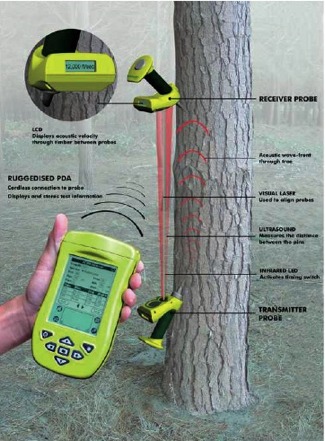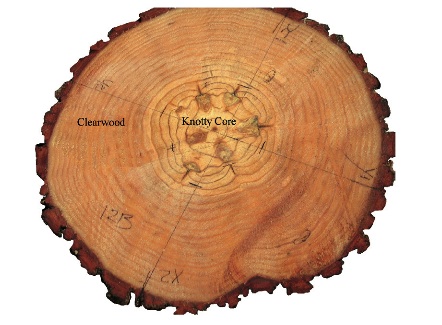Measuring radiata pine and forecasting yields
Dave Crawley, New Zealand Tree Grower May 2007.
Measuring radiata pine and forecasting yields has become a highly specialised area and there is now an increasing array of software and tools required to stay on the top of this game.
Importance of accurate yield forecasts
Realised and forecast forest values are both very dependent on log yields by grade. Different log grades such as pruned logs, small branched logs suitable for framing timber, larger branched export logs and pulp logs are worth significantly different amounts. The volume and mix of log grades actually recovered from a stand depends largely on the nature of the stand, the age at harvest, and on the range and priority of log grades cut. To get accurate forecasts, it is important to get a good description of the stand, to model the stand growth accurately through to the year of harvest, and to model log volumes recovered by grade for a range of potential cutting strategies.
Stand measurement and yield modelling
The most reliable yield forecasts are based on stand measurements. For radiata pine these usually involve measuring sample plots spread throughout a well mapped stand. Stands close to harvest age often warrant a high intensity sample with detailed tree measurements and descriptions.
PF Olsen uses Silmetra Plotsafe to gather detailed descriptions of sweep, branching, and other stem features. Plotsafe provides detailed tree descriptions by measuring these features in separate but overlapping layers. This data is modelled to forecast grade recoveries for a range of harvest years and cutting strategies. YTGen includes models that can apply growth information appropriately to individual trees rather than spread growth evenly across all trees in the stand.
Younger stands often have lower intensity samples with less detail. These samples may be collected as part of a separate mid-rotation inventory. Atlas Forecaster is also used, to forecast yields based on this type of data and is able to draw on individual tree measurements of diameter, pruned height, and a sample of tree heights, to model growth and forecast grade recoveries at the time of harvest.
Modelling log sonics for structural timber

Many New Zealand sawmills are paying significantly higher prices for good structural sawlogs. Structural timber is largely used in building applications and there are tightening regulations on how the final sawn timber must perform, especially in terms of stiffness. Sonic testing is emerging as the most reliable method for identifying the better, stiffer structural logs. Specialised tools are required to measure the sonic speed through logs, felled trees, and standing trees.
YTGen has just been extended to include models to forecast structural log yields. These models were developed by the Wood Quality Initiative and are available for their members. The models are most accurate when based on measurements of stand density assessed from wood increment cores taken from the stand, and standing tree sonic measurements.
Modelling pruned log quality
Clearwood is the wood without knots that has grown outside the central knotty core after pruning. Factors that increase clearwood include pruning on time to minimise the knotty core, and large, straight, cylindrical logs to maximise the outer clearwood volume. The standard measure used to indicate potential clearwood recovery is Pruned Log Index (PLI). Higher PLI indicates a higher clearwood component, and so higher value.
PLI can be estimated using forecasts of outer log dimensions, with measurements taken at the time of pruning to estimate the defect core dimensions. PLI estimation is fast and cheap, but it is only possible where detailed pruning measurements are available. Actual PLI can also be measured. This involves taking a representative sample of the pruned logs and either putting them through a PLI sawmill trial, or cutting them up into disks to measure PLI on site.
Future developments
 It may soon become possible for remote sensing, for example from satellites, to identify, locate and count individual stems at a reasonable price. This has the potential to improve total volume estimates and perhaps from stand stratification – segregating the stand into smaller areas where the trees are similar – to improve volume forecasts by grade, and volume forecasts for separate areas within the stand.
It may soon become possible for remote sensing, for example from satellites, to identify, locate and count individual stems at a reasonable price. This has the potential to improve total volume estimates and perhaps from stand stratification – segregating the stand into smaller areas where the trees are similar – to improve volume forecasts by grade, and volume forecasts for separate areas within the stand.
It is already possible to use survey type equipment to partially scan standing trees and record their shape electronically. If this data can be captured and interpreted into a usable format at a reasonable price, it could become valuable for refining tree shape equations, or as a validation or even replacement for the current more subjective manual tree description process.

 Farm Forestry New Zealand
Farm Forestry New Zealand